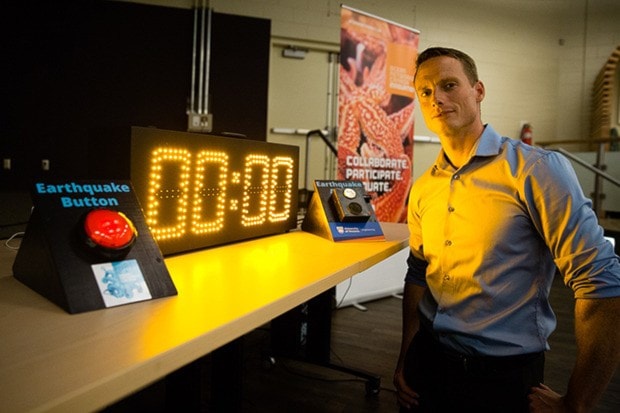Twenty seconds may not be a lot of time, but when “the Big One” hits B.C., it may be enough to get you to safety.
Last week, the University of Victoria and Ocean Networks Canada hosted “Taking Action When Seconds Count,” a demonstration of ONC’s early earthquake notification technology. The not-for-profit society established by UVic hopes to use its real-time data to alert residents in the event of a high-magnitude quake, giving them a few extra precious seconds to find safety.
Using eight sensors on the ocean floor, the ONC can measure movements in the Earth’s tectonic plates and detect an earthquake right before it happens.
“While ONC delivers the data in near real time, we need partners – federal and provincial governments, industry, academia and communities – to take that data and turn it into something that will help people before the shaking starts,” said Adrian Round, ONC’s director of observatory operations and a director of UVic’s Emergency Operations Centre.
Teron Moore, a business analyst at ONC, noted B.C. is a highly active seismic region that experiences thousands of earthquakes every year, though many aren’t felt by residents.
The province is also located on a subduction zone, where “megathrust” earthquakes, the largest of all earthquakes, can occur. The last recorded one in B.C. was on Jan. 26, 1700.
“We know it will happen again, we just don’t know when, and now is the time to prepare,” said Moore.
“When an earthquake occurs, a massive amount of energy radiates from that rupture zone outwards, from the epicentre, in a radius. This happens in the form of seismic waves.”
Moore said sensitive instruments can pick up the movement of the first seismic waves and determine the magnitude and location of an impending earthquake, as well as estimates on the type of ground shaking.
“While scientists cannot yet predict earthquakes, information about incoming earthquake shaking can deliver benefits,” he said, “including surgeons stopping surgeries, automatically triggering bay doors at ambulance and fire halls to open, or perhaps to trigger trains to slow down and for gas lines to shut off.
“Even just a few seconds of warning can allow people time to take protective actions that can save lives, reduce damage and injuries.”
Oak Bay Fire Chief Dave Cockle, who also serves as the president of the B.C. Earthquake Alliance, said early earthquake notification has been used in countries that more regularly experience earthquakes, and that B.C. should embrace the technology as it braces for some big tremors.
“In the last Chilean earthquake, they had an arrangement with the telephone networks down there that when they have an earthquake in that country, the telephones go off and light up immediately to let everybody know that something is occurring,” he said.
“That little bit of warning is just enough for you to drop, cover and hold on.”
